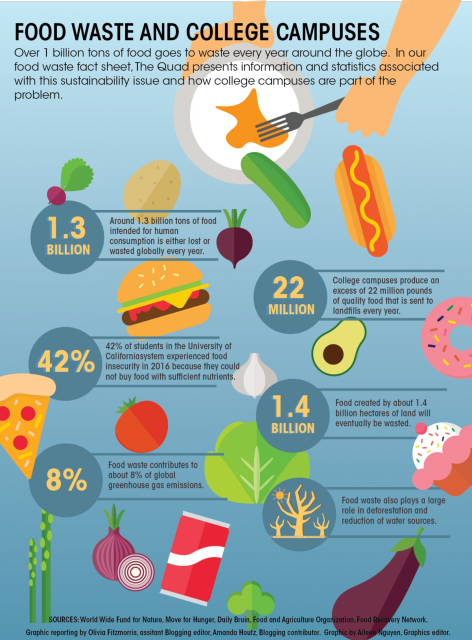Waiting in line for salmon at Bruin Plate can feel less “dining hall” and more “DMV.”
However, there’s another line when you’ve finished eating your meal, and it’s even more consequential: the line of people piling their uneaten food onto the dish return conveyor belt.
Joshua Witt, the executive steward of UCLA Dining Services, said there are about 60 to 70 pounds of prepared yet unserved food left each day in UCLA’s dining halls. This food waste is especially disturbing when juxtaposed with the fact that a whopping 42% of students within the University of California system experienced food insecurity in 2016.
According to the Food Recovery Network, college campuses produce an excess of 22 million pounds of food every year, which all goes to landfills. This abandoned food is tied to numerous consequences for students and the environment – especially if it is addressed in the wrong way.
For starters, food that ends up in the landfill can produce methane, a dangerous gas that destroys the ozone layer, producing higher global temperatures.
Further, the massive quantities of food in landfills can lead to the production of ammonia and subsequent groundwater pollution. This pollution is cruelly ironic considering the fact that 25% of the finite fresh water we have in the United States is used to produce food that will eventually be discarded.
Food waste continues to be a major problem – however, UCLA has explored several avenues to attempt to address the food waste epidemic on campus.
For example, UCLA uses a food-tracking program known as FOODPRO to try to properly gauge how much food is required for mealtimes. Leftover food from the Hill is then diverted to an organization called Bruin Dine, which coordinates the redistribution of extra dining hall food to students experiencing food insecurity. In fact, UCLA Dining aided more than 340 people by donating over 715 pounds of food to 12 Bruin Dine events last year.
Bruin Dine was formed by the collaboration of multiple groups, including Swipe Out Hunger. Swipe Out Hunger is another prominent organization on campus focused on relieving food insecurity. Sarina Morales, a fourth-year environmental science student and co-president of Swipe Out Hunger, emphasized the prevalence of food insecurity on campus and the organization’s dedication to combating it.
“UCLA likes to talk about diversity, and so if we’re gonna use diversity as a selling point for the university we have to account for the diversity of student experiences, and that means a lot of commuting students,” Morales said. “A lot of nontraditional students find it hard to pay for tuition, to pay for housing, to pay for books and to pay for food. Swipe Out Hunger is just trying to alleviate that.”
UCLA has also started initiatives to combat the adverse effects of food waste on the environment. UCLA has embarked on the #MyLastTrash campaign with the ultimate goal of sending zero waste to the landfill by 2020.
As a part of this initiative, fall 2017’s campaign theme was centered around food. In accordance with the theme, UCLA published tips on limiting food waste and on dealing with waste when it is produced.
In addition, UCLA published an explanation of how composting organic waste helps to reintroduce waste into the soil as opposed to allowing it to produce harmful methane in a landfill. Keeping to its advice, UCLA Dining doesn’t send any food waste to the landfill. Instead, food is donated, composted or safely re-served the next day at the dining halls.
It seems UCLA is taking steps in the right direction to limit food waste, but students as consumers can help, too.
The largest source of food waste comes from diners’ uneaten food at the end of the meal. The results of eight food waste audits conducted by UCLA Dining in 2018-2019 exposed that this wasted food totals an average of 2,180 pounds per day.
Though there are other things that must be considered, this staggering number indicates small changes in our own food eating patterns can result in substantial changes in the amount of waste produced.
Unfortunately, the quantity of food waste produced at UCLA is only magnified at the national and global levels.
According to the U.S. Department of Agriculture, it is estimated that 30-40% of the food supply becomes food waste in the United States. Using this estimation, they calculated that there were 133 billion pounds of food waste in 2010. And at the global level, this number grows to 1.3 billion tons.
Clearly, food waste is a powerful issue that requires an equally powerful solution. Nevertheless, as we make progress toward eradication, every effort to reduce our own and our campus’ contribution to food waste is significant.
Sustainable and mindful practices can help to set a positive precedent and pave the way for future generations of Bruins. Next time, perhaps Bruins could start with just one helping of Bruin Plate salmon before going for another.

